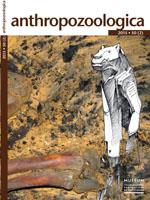Located near to the village of Azraq, in eastern Jordan, the archaeological site of Qasr al-Amra was built in the early Umayyad period, for the caliph Al-Walid I. It is especially famous for the wall paintings that have survived on the interior ceilings and walls, showing, among other subjects, hunting scenes and several zoomorphic figures. Many of these portray the ancient local fauna, including a snake (probably Walterinnesia aegyptia Lataste, 1887), several birds (herons, flamingos, cranes, peacocks and partridges), carnivores (Ursus arctos Linnaeus, 1758, Felis silvestris Schreber, 1777 and Vormela peregusna Güldenstädt, 1770), and ungulates (Syrian onagers and Persian gazelles). It is very likely that some of these illustrations were influenced by tales contained in the great Iranian epic poem Shâh Nâmeh, or “The Book of Kings”, and in other traditional Sassanid and Muslim texts.
How to translate text using browser tools
31 December 2015
The early 8th century A.D. zoomorphic iconography of the wall decorations in Qasr al-Amra, Hashemite Kingdom of Jordan
Marco Masseti
ACCESS THE FULL ARTICLE
It is not available for individual sale.
This article is only available to subscribers.
It is not available for individual sale.
It is not available for individual sale.

Anthropozoologica
Vol. 50 • No. 2
December 2015
Vol. 50 • No. 2
December 2015
black cobra
calliformes
carnivores
cobra noir
culture omeyyade
échassiers
Equus hemionus hemippus




